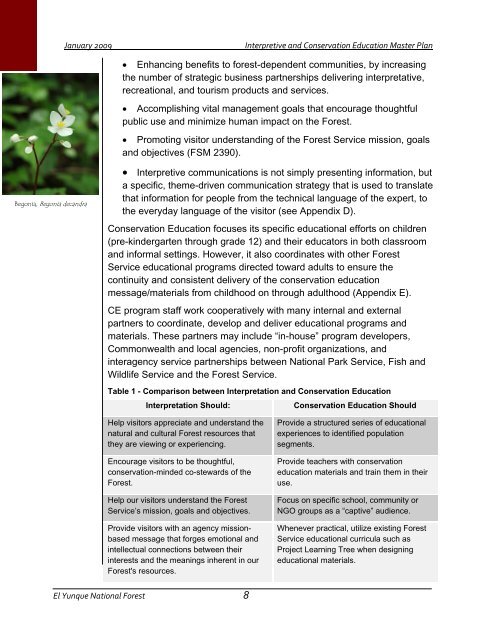2009 - USDA Forest Service
2009 - USDA Forest Service
2009 - USDA Forest Service
Create successful ePaper yourself
Turn your PDF publications into a flip-book with our unique Google optimized e-Paper software.
Begonia, Begonia decandra<br />
January <strong>2009</strong> Interpretive and Conservation Education Master Plan<br />
• Enhancing benefits to forest-dependent communities, by increasing<br />
the number of strategic business partnerships delivering interpretative,<br />
recreational, and tourism products and services.<br />
• Accomplishing vital management goals that encourage thoughtful<br />
public use and minimize human impact on the <strong>Forest</strong>.<br />
• Promoting visitor understanding of the <strong>Forest</strong> <strong>Service</strong> mission, goals<br />
and objectives (FSM 2390).<br />
• Interpretive communications is not simply presenting information, but<br />
a specific, theme-driven communication strategy that is used to translate<br />
that information for people from the technical language of the expert, to<br />
the everyday language of the visitor (see Appendix D).<br />
Conservation Education focuses its specific educational efforts on children<br />
(pre-kindergarten through grade 12) and their educators in both classroom<br />
and informal settings. However, it also coordinates with other <strong>Forest</strong><br />
<strong>Service</strong> educational programs directed toward adults to ensure the<br />
continuity and consistent delivery of the conservation education<br />
message/materials from childhood on through adulthood (Appendix E).<br />
CE program staff work cooperatively with many internal and external<br />
partners to coordinate, develop and deliver educational programs and<br />
materials. These partners may include “in-house” program developers,<br />
Commonwealth and local agencies, non-profit organizations, and<br />
interagency service partnerships between National Park <strong>Service</strong>, Fish and<br />
Wildlife <strong>Service</strong> and the <strong>Forest</strong> <strong>Service</strong>.<br />
Table 1 - Comparison between Interpretation and Conservation Education<br />
Interpretation Should: Conservation Education Should<br />
Help visitors appreciate and understand the<br />
natural and cultural <strong>Forest</strong> resources that<br />
they are viewing or experiencing.<br />
Encourage visitors to be thoughtful,<br />
conservation-minded co-stewards of the<br />
<strong>Forest</strong>.<br />
Help our visitors understand the <strong>Forest</strong><br />
<strong>Service</strong>’s mission, goals and objectives.<br />
Provide visitors with an agency missionbased<br />
message that forges emotional and<br />
intellectual connections between their<br />
interests and the meanings inherent in our<br />
<strong>Forest</strong>'s resources.<br />
El Yunque National <strong>Forest</strong> 8<br />
Provide a structured series of educational<br />
experiences to identified population<br />
segments.<br />
Provide teachers with conservation<br />
education materials and train them in their<br />
use.<br />
Focus on specific school, community or<br />
NGO groups as a “captive” audience.<br />
Whenever practical, utilize existing <strong>Forest</strong><br />
<strong>Service</strong> educational curricula such as<br />
Project Learning Tree when designing<br />
educational materials.

















